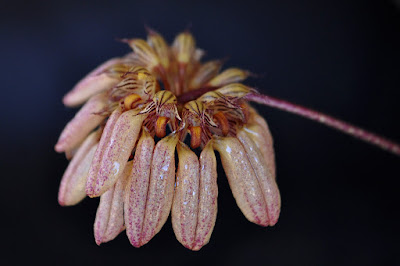Bulbophyllum sikkimense is native to Northeast India, the foothills of the Sikkim and Darjeeling provinces. Plants meet in warm, humid, tropical jungles at 250-850 m. They grow on secondary bushy vegetation and on rocks, usually close to rivers.
Bulbophyllum sikkimense, also called as The Sikkim Bulbophyllum, Cirrhopetalum sikkimense, is a species of the genus Bulbophyllum. This species was described by J.J. Smith in 1912.
IDENTIFY BULBOPHYLLUM SIKKIMENSE
Bulbophyllum sikkimense is native to Northeast India, the foothills of the Sikkim and Darjeeling provinces. Plants meet in warm, humid, tropical jungles at 250-850 m. They grow on secondary bushy vegetation and on rocks, usually close to rivers.
It is a mini-miniature sized, hot to warm growing epiphyte, which can reach the height of 6 cm, that has small squat ovate, 0.8-1.0 cm long psuedobulbs. At the top of each pseudobulb grows a single, very meaty, oval-lanceolate, 4-5 cm long and 1.5-1.8 cm wide leaf.
The Sikkim Bulbophyllum give rise in the spring to an erect, basal, bracteate, 2" (5 cm) long, 10 to 12 flowered, umbellate inflorescence that is equal to the length of the leaves. The flowers are about 1.5 cm long, yellowish with reddish brown spots. The small, 0.5 cm long, with a sharp tip and hairs at the edges, triangular, concave spine flap leans forward and forms the type of hood above the spine. The most dominant feature of the flower is the large lateral outer petals joined along the entire length forming a synsepal. The lateral outer petals are bluntly formed to form a shallow indentation in the center of the apical part of the synsepal. The small, oval-shaped oval petals of the inner whorl are round or bluntly tipped and have hairs at the edges. They are directed forward from each side of the spine. The very small lip is broadly egg-shaped at the base and narrows towards the apex.
BULBOPHYLLUM SIKKIMENSE CARE AND CULTURE
Cultural information should only be used as a guide, and should be to be adapted to suit you. Your physical location; where you grow your plants, how much time you have to devote to their care, and many other factors, will need to be taken into account. Only then can you decide on the cultural methods that best suit you and your plants.
Light:
Bulbophyllum sikkimense needs a light level of 20000-30000 lux. These plants require moderately bright light, but it should be filtered or dispersed because the direct sun can cause burns. Strong air movement should be ensured all the time.
Temperature:
The average temperature of the summer day is 29 ° C, the night 22-23 ° C, and the daily difference is 6-7 ° C. The average temperature of the winter day is 21-22 ° C, the night 7-10 ° C, and the daily difference is 13 ° C.
Humidity:
The Sikkim Bulbophyllum needs a humidity level of 85% in the summer and early autumn, then it drops steadily to 55-60% at the beginning of spring.
Substrate, growing media:
Bulbophyllum sikkimense grow best and are easiest if mounted on tree branches with uneven bark or tree ferns, because the distances between the growths on the rhizomes are quite long. The installed plants, however, require high humidity, and in hot weather may require several waterings during the day. They can also grown in very flat pots or baskets filled with loose, quickly drying ground. Mixtures of various amounts of water-retaining constituents, such as perlite or cut sphagnum moss, and fine or medium-sized bark or tree-fern fibers are used as the substrate. Woody fern fibers are preferred because they do not decompose as fast as bark, but tree ferns are often protected.
Repotting:
After repotting or division, plants often get sick for a year or even longer. If the substrate is not spread and the plant has grown out of the container, it can be removed from the container with the entire root ball and placed in a larger container or basket without moving the roots. If repotting is necessary, it is best to do it when new roots begin to grow. This allows the plant to stabilize as quickly as possible. If, however, the substrate has decomposed and is stale and remains soaked, the plant need repotted immediately.
Watering:
Bulbophyllum sikkimense should be abundantly watered during the growing season (from the end of spring to the beginning of autumn), but excellent drainage must be ensured, and the substrate around the roots should never be soggy or stale. When new growths reach maturity in autumn, the amount of water should be reduced.
Fertilizer:
It is recommended to apply a 1/4-1/2 dose of fertilizer for orchids every week during the growing season. You can use sustainable fertilizer throughout the year, or use high nitrogen fertilizer from spring to mid summer and then high phosphoric fertilizer by the end of autumn.
Rest period:
In winter, Bulbophyllum sikkimense need less water. They have to dry between waterings, but they can not stay dry for too long. For a period of about one month at the end of winter, however, they should remain dry somewhat longer between watering. Fertilization should be eliminated until new growths appear and regular watering begins.















COMMENTS